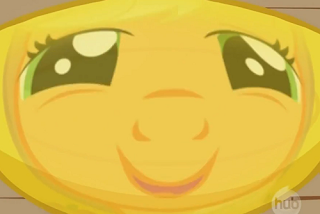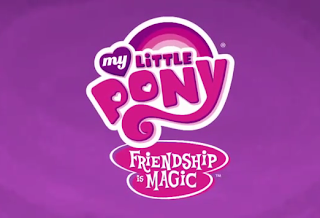 |
| Next season's creepy Twilight smile has nothing on this. |
In other news, I attend the satirical Rally to Restore Sanity and/or Fear in Washington, D.C. There is the usual round of bombings, violence, and death in Iraq and Afghanistan, the Prime Minister Silvio Berlusconi of Italy responds to reports that he's sleeping with a 17-year-old girl by saying that it's better than being gay, and the Republicans make major gains in the U.S. House of Representatives.
But hey, even with all the horrors of war, pedophiliac homophobes, and Republicans, we have ponies to cheer us up, right? So here's our latest episode... by Amy Keating Rogers, flying solo this time. Joy. And it's an Applejack episode. Double joy.
And yet, somehow... it is joyous. This episode actually works, and it points toward a type of story that Friendship Is Magic suits extremely well. You see, there are basically two main types of Friendship Is Magic episodes, adventures and character studies. (Binary alert! Expect to see this shattered by the end of January at the latest.) In adventures, the Mare in the Moon/Elements of Harmony two-parter, for example, the ponies deal with some kind of external threat, usually a monster. Adventures, as the name implies, tend to be more exciting, and they also tend to be rich in information about the world of Equestria. Character studies, such as "The Ticket Master" and this week's episode, involve one or two ponies dealing with an internal or interpersonal conflict. Again as the name implies, character studies tend to be rich in information about one or two characters.
Last week's episode was a particular subtype of character study in which we learn more about the characters by seeing how they handle conflicts with each other. We'll see more of that type later. This, however, is another subtype; it's the first episode in which we learn more about a character by watching her slowly descend into comedic madness (hereafter called character collapse stories). Meghan McCarthy, who is probably the show's best writer, will largely earn that title by absolutely mastering this structure with episodes like "Party of One" and "Lesson Zero," so it's perhaps a bit surprising that its first instance isn't her work, but Rogers'.
It's also surprising that the first real character study is about Applejack. I said last week that Rarity is in some ways the hardest character to write, but an argument could be made for Applejack being just as hard. The problem with Applejack is that she's hardworking, honest, dedicated to her family and friends, athletic--all perfectly good traits, but not particularly funny or exciting or dramatic to watch. The challenge with Applejack is thus to make her interesting.
This episode manages that by making her fall apart, and put that way Applejack becomes the obvious starting point for descent stories. Of course the sturdiest, most reliable, most staid and boring pony is the funniest to watch stumbling around in a daze! And once that's established, it makes sense for Rogers to be the one to write it; as hard as I was on her last week, she does have her strengths: she's good at comedy, and those characters she writes well, she writes very well, namely Applejack and Pinkie Pie. Given that the point of this episode is to transform Applejack into a well-meaning force of pure chaos who babbles incomprehensible things in response to other ponies--into Pinkie Pie, in other words--Rogers is the natural choice.
In a character collapse, we see the character's strengths and persona (here meaning something close to its original Latin meaning of "mask"--the face a person wears to interact with others) stripped away to reveal the underlying flaws. That in itself is fun, but a well-done character collapse does more: as the layers of the character's persona burn away, we can see which are more integral to who the character is because they take longer to ablate. Then, once the character is completely destroyed, they can be rebuilt with a fresh understanding of who they are--not a retcon, ideally, but a new perspective. Further, by showing how other characters react to the collapse, the show tells us about what matters to them, as well.
Consider the progression of Applejack's breakdown in sequence: First, she's late for her own award ceremony, right after Rainbow Dash asserted that Applejack is never late. This suggests, first of all, that while Applejack is normally extremely punctual it's not actually that important an element of who she is. More importantly, it suggests that receiving an award is not that critical or important to her. It's hard to imagine Rainbow Dash, even in the early stages of a breakdown, not being on time for an award ceremony in her honor, but Applejack is different. (Not better or worse, mind you, just different. And yes, I know, "The Last Roundup," but there Applejack's shame wasn't that she came in second, but that because she came in second, she couldn't keep her promises to help the town out with the prize money.)
Next, at that same award ceremony, we see that she is frazzled, silly, and messy--her face and mane a mess, dropping apples everywhere, and laughing at her reflection with Pinkie Pie. Each of four characters respond differently: Twilight Sparkle with nonspecific but intense concern, Fluttershy notices Applejack's clumsiness, Rarity her unkempt appearance, and Rainbow Dash her exhaustion. Put another way, Twilight Sparkle notices something is wrong and frets about it but can't correctly identify the problem or appropriate response, because she's a natural worrier verging on neurotic. Fluttershy has a more specific concern, that Applejack is clumsy, i.e. likely to accidentally hurt herself or others. It's again a very appropriate concern for the character, because Fluttershy is fearful of precisely that, and thus moves and speaks with exaggerated caution and care.
As for Rarity... well, as I said in the last post, I think Rogers doesn't have a good grasp of Rarity's character, and tends to write her as shallow and judgmental. I suspect that's what's intended with Rarity's line here, and certainly it's where the comedy comes from. However, look at Rainbow Dash's comment. Rainbow Dash is disturbed by seeing her normally energetic friend so tired, because Rainbow Dash's own boundless energy, her sped and athletic ability, are core elements of her identity that she protects fiercely (hence the constant naps). Rainbow would never allow herself to become that tired unless something were very wrong, and therefore she finds it the most worrisome aspect of Applejack's behavior.
We can use the same observations to give Rarity a much more sympathetic (albeit probably unintentional) read of this scene: Rarity values status. It is important to her to be thought well of by other ponies, and she accomplishes this by carefully controlling how she appears. This is not in itself a shallow concern--it is, ultimately, the same thing Rainbow Dash is seeking. The only difference is that Rainbow Dash wants to gain status and accolades within the sports world and join the elite Wonderbolts, while Rarity wants to gain status and accolades within high society and join the elite known as the elite. For Rarity to make a public appearance looking as unkempt as Applejack in this scene would be a sign of something deeply wrong with her, and thus her statement is not a judgment, but an expression of concern for Applejack just as much as Rainbow Dash's.
We next see Applejack struggling to buck apples. She is pretty much already incompetent at her job at this point: She spills apples everywhere and keeps falling into microsleeps. She's far too exhausted to work, but continues trying. We can thus see how the collapse converts her strengths into flaws: her determination to finish her task is stronger than her desire to do it well, and thus she enters a cycle of working, messing up, and cleaning up her mess that probably takes a lot longer than if she just got in a nap and then got back to work. Although Applejack is often depicted as the "sensible" member of the group, her determination can override her sensibility, which at this point is clearly gone. As she talks to Twilight in this scene, however, she quickly perks awake when she believes she's been challenged, showing us that even stronger than her determination (which keeps her working, but not awake) is her competitiveness. This is a dangerous combination, and becomes the stubborn pride that undoes her throughout the episode; she rejects help because her desire to "win" against her exhaustion is greater than her determination to complete the task.
The next few scenes (with one exception, which we'll get to in a bit) serve as set pieces to reiterate the concerns the other ponies showed previously: with Rainbow Dash Applejack is late (i.e., slow) and fails at athletic tasks, while in the bunny sequence Applejack ignores Fluttershy's cautions and herds the bunnies sloppily and clumsily, resulting in a sublimely ridiculous sequence of bunnies stampeding through Ponyville that achieves its apotheosis of nonsense in an aerial shot of the bunnies stampeding around a fainted pony, all scored and shot as if bunnies are a serious and terrifying threat. As I've said, for all her faults, Rogers knows comedy. (Director James Wootton and composer William Kevin Anderson also deserve credit for the hilarity of this scene, but they are the director and background composer for every episode of the first two seasons; Rogers is the element special to this episode.)
After each Applejack-causes-disaster set piece, we get a Twilight-confronts Applejack set piece that carries on Twilight's thread from the initial award scene. In that scene, we established that Twilight is unable to correctly diagnose or respond appropriately to Applejack's problem, and that continues here. Twilight identifies the problem as Applejack overworking, but that is a symptom, not a cause; the real problem is that, while Applejack's exhaustion has cleaved away her competence, self-control, and ability to retain consciousness for extended periods, it is still not strong enough to overcome her determination to keep her promises and competitive drive to win. Twilight attempts to use her default tools of reason and communication to solve Applejack's problem, but all this accomplishes is setting herself up as another competitor, a foe to defeat and naysayer (neighsayer?) to prove wrong, giving Applejack's competitiveness even more power to overcome her exhaustion.
Of course, one pony expressed no concern about Applejack in the first scene: Pinkie Pie. Her scene is thus a little different from the ones on either side. It does carry on a theme from the award scene, but not the response of another pony to Applejack's distress, since Pinkie Pie had none. Rather, it continues the implications of Applejack transforming into Pinkie Pie by having her out-Pinkie Pinkie. Applejack introduces non sequiturs into the recipe, makes bizarre leaps of logic (how do go from "wheat worms" to "earthworms?"), and casually accepts the utterly bizarre (muffins with worms in them?) while maintaining a positive attitude, resulting in chaos. However, where Pinkie Pie's chaos is generally silly and fun, Applejack's is destructive, to the point of even poisoning Pinkie Pie (the first of a very short list of occasions on which anything manages to hurt Pinkie Pie, who is normally indestructibly cartoony). Applejack has now replaced Pinkie Pie as the primary source of chaos in Ponyville (note that Pinkie Pie does not appear again until Applejack returns to normal), and disaster ensues.
Each of the four scenes in which Applejack goes to Ponyville steadily ratchet up the degree of disaster her ongoing character collapse creates: in the award scene, she embarrasses only herself; practicing the trick with Rainbow Dash, she does slapstick comedic damage to both of them and Twilight's house; with Pinkie Pie she poisons a couple of dozen ponies; and with Fluttershy she causes a stampede that terrorizes the entire town. (For all that the scene is played for laughs, we are clearly supposed to read the ponies' fear as genuine.) However, Applejack is still unwilling to face the damage her stubbornness is causing, because none of these things--the physical and emotional well-being of others, her own skills, her social standing, reason and efficiency, pleasing others--are as important to her as her competitiveness (especially with Twilight repeatedly enflaming it) and determination. A character collapse cannot end until the character is completely destroyed--one must first die to be reborn--and so there must be an ultimate disaster before the episode can resolve, an event that is, for Applejack at least, the worst possible thing that could happen. This ultimate disaster tells us what lies at the absolute core of the character, because it removes that absolute core and thus destroys the character completely.
For Applejack, the final straw is discovering that all her work has only harvested a fraction of the apples on the farm; acres of orchard still remain. Remember what event in the pilot gave Twilight the clue that Applejack was the Element of Honesty: Applejack promised Twilight it was safe to let go, and Twilight instinctively knew to trust her. Applejack keeps her promises. When all else is stripped away and she is staggering around Sweet Apple Acres failing even to hit the trees, Applejack still will not stop if there is a promise to be kept. The ultimate disaster is thus the discovery that she cannot keep her promise, the realization that she was wrong to make the promise in the first place and Big Macintosh was right that it's impossible. Her competitiveness and determination find themselves in conflict, she breaks her word, and her collapse is complete.
Of course, the moment she ceases to exist as a character, she is no longer an obstacle to the other ponies helping her and no longer able to harm herself. She gets the rest she needs, Pinkie Pie returns both to the screen and to being Ponyville's resident force of chaos, and right is restored. Having stripped away who Applejack is layer-by-layer, the writers can put her back all at once with new understanding of why she does what she does. In turn, this means she can be used to explore other characters by comparing and contrasting them with her; while "Look Before You Sleep" and "Fall Weather Friends" would still be quite doable if this episode didn't exist, "Applebuck Season" adds a lot of texture to those later Applejack-and-Somepony-Else character studies.
Next week: A griffon earns a place in that special hell reserved for people who are mean to Fluttershy.


